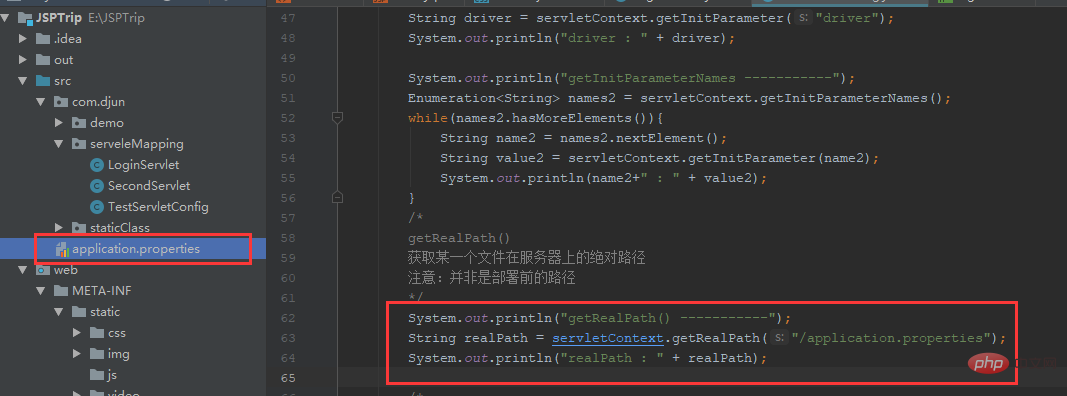ServletConfig对象有四个方法。

getInitParameter、 getInitParameterNames、 getServletName
(1)getInitParameter、 getInitParameterNames用于获取Web.xml中的参数名、参数值。
(2)getServletName 获取 Web.xml中的 Servlet-name。
实例
下面是Web.xml的文件内容:
<?xml version="1.0" encoding="UTF-8"?>
<web-app xmlns="http://xmlns.jcp.org/xml/ns/javaee"
xmlns:xsi="http://www.w3.org/2001/XMLSchema-instance"
xsi:schemaLocation="http://xmlns.jcp.org/xml/ns/javaee http://xmlns.jcp.org/xml/ns/javaee/web-app_4_0.xsd"
version="4.0">
<servlet>
<servlet-name>TestServletConfig</servlet-name>
<servlet-class>com.djun.serveleMapping.TestServletConfig</servlet-class>
<!--配置Servlet的初始化参数-->
<!-- 如何获取初始化的参数?
1、getInitParameter(String name)
Returns a String containing the value of the named initialization parameter,
or null if the parameter does not exist.
2、 getInitParameterNames()
Returns the names of the servlet's initialization parameters as an Enumeration of String objects,
or an empty Enumeration if the servlet has no initialization parameters.
-->
<init-param>
<param-name>username</param-name>
<param-value>admin</param-value>
</init-param>
<init-param>
<param-name>passworld</param-name>
<param-value>admin</param-value>
</init-param>
<!--
指定Servlet JSP被创建的时机
若数值 a<0,则仅在第一次的时候被创建。
若 a>=0 , 则在当前应用被Servlet容器加载时创建实例
数值越小越早被创建
-->
<load-on-startup>1</load-on-startup>
</servlet>
<servlet-mapping>
<servlet-name>TestServletConfig</servlet-name>
<!--只要后缀为html的文件都由该类处理-->
<url-pattern>/servletConfig</url-pattern>
</servlet-mapping>
</web-app>import javax.servlet.*;
import java.io.IOException;
import java.util.Enumeration;
public class TestServletConfig implements Servlet {
@Override
public void init(ServletConfig servletConfig) throws ServletException {
System.out.println("Init TestServletConfig...");
System.out.println("-----------执行getInitParameter--------");
String username = servletConfig.getInitParameter("username");
String passworld = servletConfig.getInitParameter("passworld");
System.out.println("username: " + username+"\n"+"password : "+passworld);
System.out.println("----------执行getInitParameterNames------");
Enumeration<String> names = servletConfig.getInitParameterNames();
while(names.hasMoreElements()){
String name = names.nextElement();
String value = servletConfig.getInitParameter(name);
System.out.println("username: " + name+"\n"+"password : "+value);
}
String servletName = servletConfig.getServletName();
System.out.println(servletName);
}
@Override
public ServletConfig getServletConfig() {
return null;
}
@Override
public void service(ServletRequest servletRequest, ServletResponse servletResponse) throws ServletException, IOException {
System.out.println("TestServletConfig....");
}
@Override
public String getServletInfo() {
return null;
}
@Override
public void destroy() {
}
}getServletContext
(1)Servlet为每个Web应用程序都创建了一个对应的ServletContext对象,ServletContext对象被包含在ServletConfig对象中,通过调用 ServletContext.getServletContext()方法可以返回ServletContext对象的引用。
(2) 由于一个Web应用程序中的所有Servlet都共享同一个ServletContext对象,所以,ServletContext对象被称为application对象(也就是web应用程序对象)。
(1) getRealPath()
获取某一个文件在服务器上的绝对路径,注意:并非是部署前的路径。
注意我的下面文件存放的目录
 (2) getContextPath()
(2) getContextPath()
获取当前Web应用的某一个文件对应的输入流。
System.out.println("getContextPath() -----------");
String contextPath = servletContext.getContextPath();
System.out.println(contextPath);
String fileName = "application.properties";
try {
File file = new File(realPath+ "/" + fileName);
ClassLoader classLoader = getClass().getClassLoader();
InputStream is = classLoader.getResourceAsStream(realPath + "/" + fileName);
System.out.println(realPath+ "/" + fileName);
System.out.println("1. "+ is);
} catch (Exception e) {
e.printStackTrace();
}以上是Servlet JSP之 ServletConfig对象的详细内容。更多信息请关注PHP中文网其他相关文章!
 是否有任何威胁或增强Java平台独立性的新兴技术?Apr 24, 2025 am 12:11 AM
是否有任何威胁或增强Java平台独立性的新兴技术?Apr 24, 2025 am 12:11 AM新兴技术对Java的平台独立性既有威胁也有增强。1)云计算和容器化技术如Docker增强了Java的平台独立性,但需要优化以适应不同云环境。2)WebAssembly通过GraalVM编译Java代码,扩展了其平台独立性,但需与其他语言竞争性能。
 JVM的实现是什么,它们都提供了相同的平台独立性?Apr 24, 2025 am 12:10 AM
JVM的实现是什么,它们都提供了相同的平台独立性?Apr 24, 2025 am 12:10 AM不同JVM实现都能提供平台独立性,但表现略有不同。1.OracleHotSpot和OpenJDKJVM在平台独立性上表现相似,但OpenJDK可能需额外配置。2.IBMJ9JVM在特定操作系统上表现优化。3.GraalVM支持多语言,需额外配置。4.AzulZingJVM需特定平台调整。
 平台独立性如何降低发展成本和时间?Apr 24, 2025 am 12:08 AM
平台独立性如何降低发展成本和时间?Apr 24, 2025 am 12:08 AM平台独立性通过在多种操作系统上运行同一套代码,降低开发成本和缩短开发时间。具体表现为:1.减少开发时间,只需维护一套代码;2.降低维护成本,统一测试流程;3.快速迭代和团队协作,简化部署过程。
 Java的平台独立性如何促进代码重用?Apr 24, 2025 am 12:05 AM
Java的平台独立性如何促进代码重用?Apr 24, 2025 am 12:05 AMJava'splatformindependencefacilitatescodereusebyallowingbytecodetorunonanyplatformwithaJVM.1)Developerscanwritecodeonceforconsistentbehavioracrossplatforms.2)Maintenanceisreducedascodedoesn'tneedrewriting.3)Librariesandframeworkscanbesharedacrossproj
 您如何在Java应用程序中对平台特定问题进行故障排除?Apr 24, 2025 am 12:04 AM
您如何在Java应用程序中对平台特定问题进行故障排除?Apr 24, 2025 am 12:04 AM要解决Java应用程序中的平台特定问题,可以采取以下步骤:1.使用Java的System类查看系统属性以了解运行环境。2.利用File类或java.nio.file包处理文件路径。3.根据操作系统条件加载本地库。4.使用VisualVM或JProfiler优化跨平台性能。5.通过Docker容器化确保测试环境与生产环境一致。6.利用GitHubActions在多个平台上进行自动化测试。这些方法有助于有效地解决Java应用程序中的平台特定问题。
 JVM中的类加载程序子系统如何促进平台独立性?Apr 23, 2025 am 12:14 AM
JVM中的类加载程序子系统如何促进平台独立性?Apr 23, 2025 am 12:14 AM类加载器通过统一的类文件格式、动态加载、双亲委派模型和平台无关的字节码,确保Java程序在不同平台上的一致性和兼容性,实现平台独立性。
 Java编译器会产生特定于平台的代码吗?解释。Apr 23, 2025 am 12:09 AM
Java编译器会产生特定于平台的代码吗?解释。Apr 23, 2025 am 12:09 AMJava编译器生成的代码是平台无关的,但最终执行的代码是平台特定的。1.Java源代码编译成平台无关的字节码。2.JVM将字节码转换为特定平台的机器码,确保跨平台运行但性能可能不同。
 JVM如何处理不同操作系统的多线程?Apr 23, 2025 am 12:07 AM
JVM如何处理不同操作系统的多线程?Apr 23, 2025 am 12:07 AM多线程在现代编程中重要,因为它能提高程序的响应性和资源利用率,并处理复杂的并发任务。JVM通过线程映射、调度机制和同步锁机制,在不同操作系统上确保多线程的一致性和高效性。


热AI工具

Undresser.AI Undress
人工智能驱动的应用程序,用于创建逼真的裸体照片

AI Clothes Remover
用于从照片中去除衣服的在线人工智能工具。

Undress AI Tool
免费脱衣服图片

Clothoff.io
AI脱衣机

Video Face Swap
使用我们完全免费的人工智能换脸工具轻松在任何视频中换脸!

热门文章

热工具

螳螂BT
Mantis是一个易于部署的基于Web的缺陷跟踪工具,用于帮助产品缺陷跟踪。它需要PHP、MySQL和一个Web服务器。请查看我们的演示和托管服务。

EditPlus 中文破解版
体积小,语法高亮,不支持代码提示功能

ZendStudio 13.5.1 Mac
功能强大的PHP集成开发环境

安全考试浏览器
Safe Exam Browser是一个安全的浏览器环境,用于安全地进行在线考试。该软件将任何计算机变成一个安全的工作站。它控制对任何实用工具的访问,并防止学生使用未经授权的资源。

SublimeText3 Mac版
神级代码编辑软件(SublimeText3)





